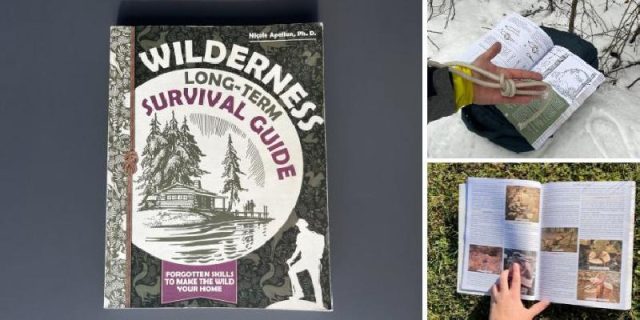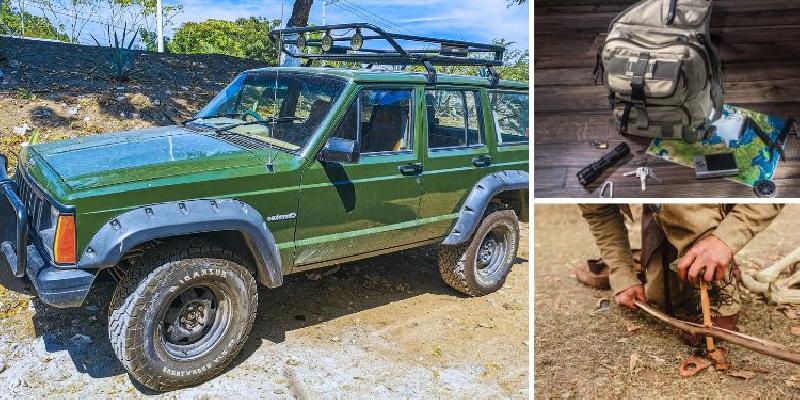As you probably already know, here at Ask a Prepper, we’re always doing our best to unearth the lost skills of our forefathers. It’s these skills that will help us in the dark times ahead!
For years now, I’ve been looking for a book that covers our ancestors’ survival skills that helped them live in the wild. I got tired of guides that show nothing but the tip of the iceberg when it comes to survival.
Many of the authors haven’t even tried to live in the wild themselves. Whenever I grab one of those, I feel like it’s nothing more than a printed ad for expensive equipment that’s supposed to help you survive. These are only good as fire starters for your fireplace.
Not long ago, a good friend recommended the Wilderness Long-Term Survival Guide. It’s written by Nicole Apelian—the woman who survived 57 days on her own in the wilderness on the remote Vancouver Island on History Channel’s Alone—I figured she knows a thing or two about surviving in the wild… so I ordered it right away.
After all, she managed to survive almost two months with little more than a knife and her knowledge.
What drew my attention first is that Nicole referred to our ancestors, supporting the same idea I do: that they didn’t just survive in the wilderness—they lived there and called it home! For them, survival was a way of life!
Our ancestors mastered essential survival skills, from self-sustaining fires to building shelters without our modern, helpful tools.
They developed expertise in identifying common medicinal plants and foraging for food as part of their daily routine.
Additionally, they honed the art of crafting traps for hunting, ensuring their ability to secure food in challenging circumstances.
After I placed my order, I received the guide in a hard cardboard package, and it’s a very good-looking book, if I may say so. The delivery time wasn’t that bad either. In about three days, I had already received it
The paper and picture quality exceeded my expectations even before I went to the content.
I like that the chapters are very well structured. They start with the most important things for survival: how to build a shelter, start a fire, get water that is safe to drink, find edible plants, and make traps.
Our forefathers needed strong shelters in which they could live for long periods, and I’m happy to say I found three types of shelters here that I can also make in the wild. I knew one of them—the short-term one—but I also found a one-month shelter and a long-term one as well as the instructions for each of them.
Another chapter I was pleased to find was the one on fires. I particularly liked the Swedish fire. It works like a rocket stove that burns for many hours and needs no extra wood. I was also intrigued by something called the self-feeding fire. You set it up and don’t have to deal with it for up to 14 hours.
Something else I loved is the part about water. There is an interesting technique that shows you how to make water from thin air. And all you need is a plastic bag and a small rock.
In my experience as a survivalist and prepper, I’ve learned that when you’re in the wild, you can’t always rely on fishing and hunting. That’s why I am glad this guide has lots of information on edible plants, with pictures and descriptions that will make identification a lot easier.
The guide has a map covering all of the United States and its most common edible plants along with a very detailed list of their poisonous lookalikes.
I find this information really useful—and I’ll tell you why. In a forest nearby, I saw some blueberries that I thought were safe to eat. I was about to make a huge mistake…. They’re called black nightshade, and they are the poisonous lookalike of the blueberry, one of the most common fruits to be found in any forest-like area. I couldn’t have known that without this guide.
I am so pleased I finally found something that covers all these survival skills so well. And apart from the information, I love the high-quality paper. It feels like I can take it with me in the wild and not have to worry it will be destroyed by a few drops of water.
They knew how to craft weapons, containers, and all the necessary tools to live a long time in the wild. Remember, they didn’t have our modern equipment, like pepper sprays against animals, so they had to craft their own weapons and tools, such as the primitive hafted stone axe or the primitive spear.
It’s a shame not all images are human-made projects—some are just sketches, like those for the traps— but they still make a good blueprint of how to build snares, deadfall traps, or pitfall traps.
I was already familiar with a few skills, and it felt pretty good to jog my memory. But there were still plenty of new skills that never crossed my mind. And it’s the only guide I’ll take with me in my bug-out bag if I’m ever forced to leave my home.
I’m sure the information found in the Wilderness Long-Term Survival Guide will one day prove to be lifesaving, and I think even if you don’t have to head for the woods right now, it surely adds a new level of preparedness everyone needs.
You may also like:
The Great Depression Was Nothing Compared to This
The Berry That Is Illegal to Grow, But Perfectly Fine to Forage (Video)
Foods You Should Never Cook in Cast Iron
How To Understand the Signals From Animals Just Before a Natural Disaster Strikes
via askaprepper




